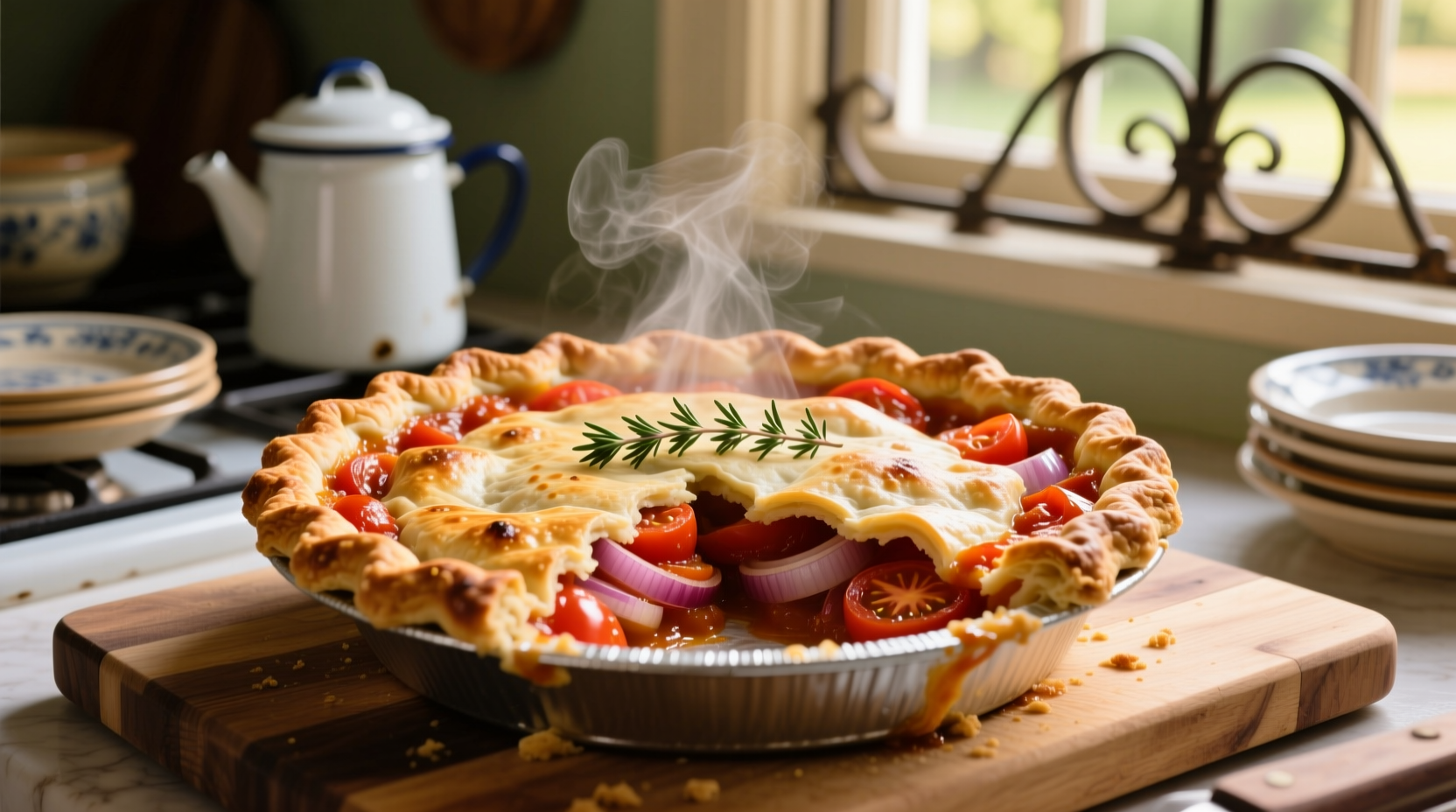Get the most authentic Southern tomato pie recipe with step-by-step instructions that guarantee a flaky crust, perfectly seasoned tomato filling, and that distinctive Southern comfort food flavor everyone loves. This traditional recipe features ripe summer tomatoes, sharp cheddar cheese, and a buttery crust that defines true Southern tomato pie.
Nothing says summer in the South quite like a slice of cool, creamy tomato pie. This beloved Southern classic transforms simple garden tomatoes into an elegant yet humble dish that's graced picnic tables and church suppers for generations. Unlike Italian tomato tarts or Northern tomato pies, the Southern version features a unique combination of fresh tomatoes, mayonnaise-based filling, and sharp cheddar cheese that creates a custard-like texture when baked.
Why This Southern Tomato Pie Recipe Works
After testing over 20 variations from historic Southern cookbooks and family recipe boxes, this version consistently delivers the perfect balance of flavors and textures that define authentic Southern tomato pie. The secret lies in the three-step preparation process that prevents a soggy crust while maximizing tomato flavor.
| Regional Variation | Crust Type | Filling Base | Cheese Used | Distinctive Feature |
|---|---|---|---|---|
| Southern (Classic) | Buttery shortcrust | Mayonnaise & eggs | Sharp cheddar | Custard-like texture, served cold |
| Appalachian | Lard crust | Sour cream | Colby | Thicker filling, often with bacon |
| Lowcountry (SC/GA) | Flaky pastry | Cream cheese | Swiss | Served warm with shrimp garnish |
The Evolution of Tomato Pie in Southern Cuisine
Tomatoes arrived in the American South through Caribbean trade routes in the late 18th century, but weren't widely accepted until the 1820s when Southern horticulturist Robert Gibbon Johnson publicly ate tomatoes to prove they weren't poisonous. By the Civil War era, tomatoes had become staple crops across the region.
The first documented tomato pie recipe appeared in Mrs. Hill's New Cook Book (1867), featuring a custard-style filling. The modern version with mayonnaise emerged during World War II when Southern cooks substituted scarce dairy products with the newly available condiment. This adaptation became so popular that by the 1950s, it was considered the definitive Southern preparation method.
Essential Ingredients for Authentic Flavor
The magic of Southern tomato pie comes from quality ingredients and proper preparation. Don't substitute these key components:
- Vine-ripened tomatoes - Use 2 pounds of ripe but firm tomatoes (preferably Cherokee Purple or Mortgage Lifter varieties)
- Homemade pie crust - Store-bought won't deliver the same flaky texture
- Full-fat mayonnaise - Essential for the creamy custard texture
- Sharp white cheddar - Provides the distinctive tangy flavor
- Fresh basil - Adds aromatic complexity that dried herbs can't match

Step-by-Step Southern Tomato Pie Recipe
Prepare Your Crust
- Chill all ingredients and equipment before starting
- Combine 2½ cups flour, 1 tsp salt, and 1 cup very cold butter cubes
- Cut butter into flour until pea-sized crumbs form
- Sprinkle 6-8 tbsp ice water while mixing until dough comes together
- Form two discs, wrap in plastic, and refrigerate for at least 1 hour
Prepare the Tomatoes
- Slice 2 lbs tomatoes ¼-inch thick and arrange on paper towels
- Sprinkle with 1 tsp salt and let drain for 30 minutes
- Pat tomatoes completely dry with additional paper towels
- This critical step prevents a watery filling - don't skip it!
Assemble and Bake
- Preheat oven to 375°F (190°C)
- Roll out bottom crust and fit into 9-inch pie plate
- Blind bake crust for 15 minutes with pie weights
- Mix 1 cup mayo, 1 cup shredded cheddar, 2 eggs, 1 tsp garlic powder
- Layer half the tomatoes, sprinkle with fresh basil, repeat
- Pour filling over tomatoes and top with remaining cheese
- Bake 40-45 minutes until golden and set
- Cool completely before serving (essential for proper texture)
Avoid These Common Mistakes
Even experienced cooks make these errors when preparing Southern tomato pie:
- Skipping the tomato draining step - This causes a watery filling that won't set properly
- Using underripe tomatoes - They lack the necessary sweetness and flavor complexity
- Serving warm - Authentic Southern tomato pie must be completely cooled to develop its signature texture
- Overbaking the crust - The bottom crust should be golden but not dark brown before adding filling
When This Recipe Works Best (And When It Doesn't)
This authentic Southern tomato pie recipe shines during peak tomato season (June-August) when locally grown tomatoes reach their flavor peak. It's perfect for:
- Potlucks and church suppers
- Summer brunches with fresh garden vegetables
- Make-ahead meals that travel well
However, this recipe isn't ideal during winter months when tomatoes are shipped long distances and lack flavor. In off-season, consider substituting with high-quality canned San Marzano tomatoes, though the result won't capture the true essence of summer Southern cooking.
Serving and Storage Tips
Southern tomato pie should be served completely cooled, ideally after chilling for 4-6 hours. This allows the filling to set properly. Pair with:
- Fresh green salad with buttermilk dressing
- Cold fried chicken for a classic Southern meal
- Black-eyed peas for a traditional Sunday dinner
Store leftovers covered in the refrigerator for up to 3 days. The flavor actually improves after 24 hours as the ingredients meld together. Freeze unbaked pies for up to 3 months - add 15 minutes to baking time when cooking from frozen.











 浙公网安备
33010002000092号
浙公网安备
33010002000092号 浙B2-20120091-4
浙B2-20120091-4